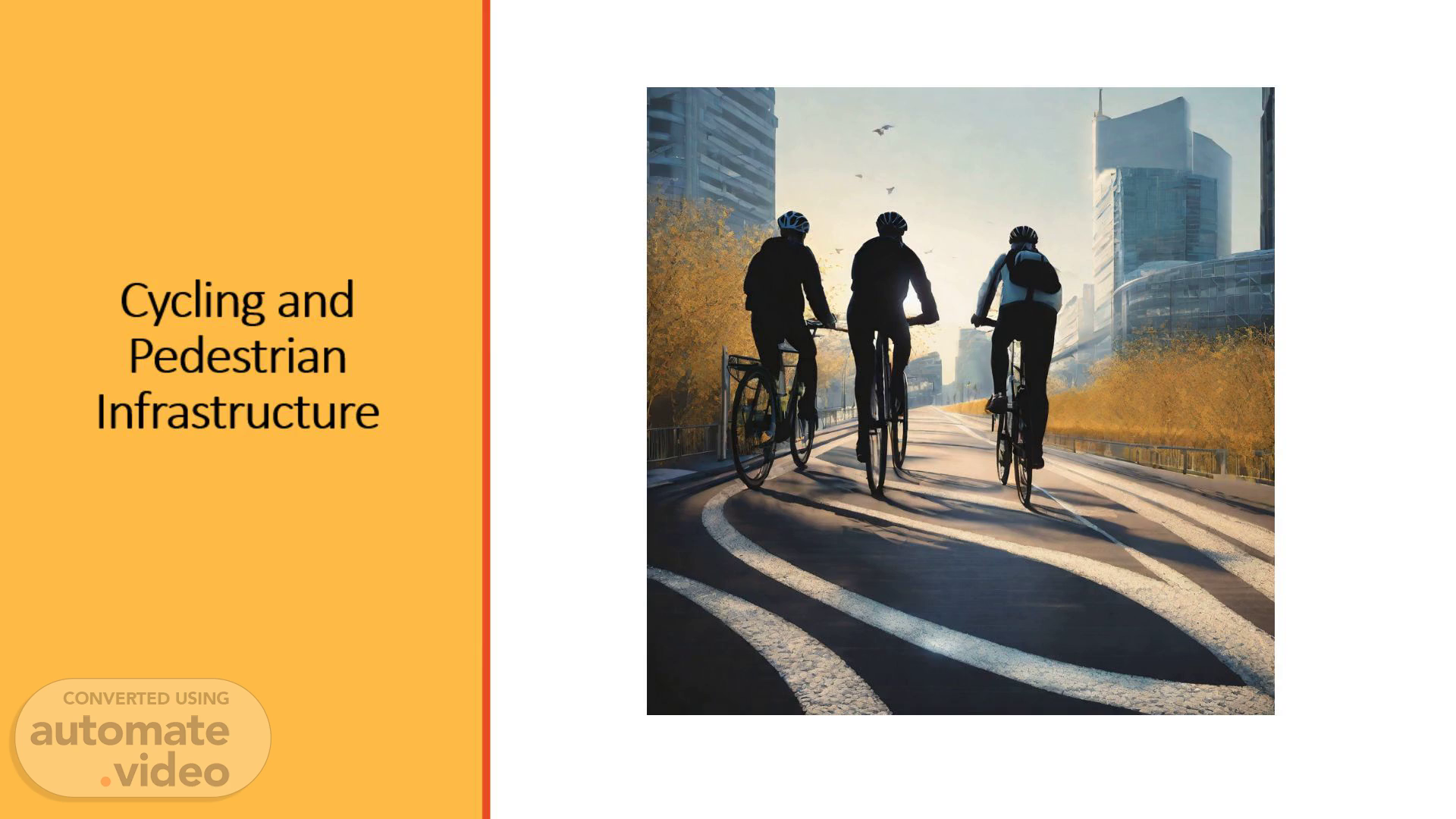
Cycling and Pedestrian Infrastructure
Scene 1 (0s)
[Audio] Good morning everyone. Today we will be discussing the significant benefits and challenges of improving cycling and pedestrian infrastructure. We will explore how such improvements can lead to improved physical and mental health, reduced traffic congestion, decreased carbon emissions, increased community engagement, and the resistance from motorists and local businesses. With these ideas in mind, let us begin our presentation..
Scene 2 (28s)
[Audio] As cities and towns look to become more sustainable and reduce their carbon footprint, cycling and pedestrian infrastructure has become increasingly essential. Bike lanes, pedestrian pathways, and greenways create a safe and comfortable way to move around the community while also promoting active and healthy lifestyles. Furthermore, these projects create public spaces that bring people together and cultivate a vibrant atmosphere..
Scene 3 (55s)
[Audio] Cycling and walking offer a range of advantages for physical and mental health, our environment, our communities and more. As a form of transportation, active travel has become a more and more popular choice for getting to and from places, as well as for recreational activities. Data suggests that cycling and walking can decrease traffic, lessen carbon emissions and up the amount of involvement in the community. Furthermore, it's a fun and affordable way to stay in shape. Therefore, take a stroll or a bike ride the next time you need to go somewhere..
Scene 4 (1m 31s)
[Audio] In order to improve cycling and pedestrian infrastructure, two of the main challenges and obstacles that need to be overcome are resistance from motorists and local businesses, as well as limited funding. To address these issues, comprehensive planning and coordination must take place, involving cooperation between various stakeholders. Through this approach, it is possible to ensure that the necessary funds and ongoing maintenance are provided so that these infrastructure projects are effectively implemented..
Scene 5 (2m 2s)
[Audio] The safety of cyclists and pedestrians can be significantly impacted by the level of cycling and pedestrian infrastructure in any given area. Lanes may not be dedicated, and signage may not be clear, resulting in a greater risk of accidents. Additionally, the lack of connectivity between different cycling and pedestrian routes can make it difficult for people to travel without interruption. It is essential that cities and towns allocate funding and resources to improve the infrastructure for both cyclists and pedestrians, in order to reduce accidents and injuries..
Scene 6 (2m 37s)
[Audio] Providing infrastructure for cycling and walking has numerous advantages for hikers, cyclists, and all travelers. Bike lanes provide a specific space for cyclists, allowing them to ride securely and separately from motor vehicle traffic. Pedestrian crosswalks enable pedestrians to cross roads and intersections safely. Also, shared-use paths create a distinct path for non-motorized transportation that can be used by both cyclists and pedestrians. Altogether, this infrastructure offers a healthy, sustainable, and cost-effective way to travel..
Scene 7 (3m 15s)
[Audio] In order to improve safety for cyclists and pedestrians, implementing measures such as speed bumps, roundabouts and traffic islands can help to ensure vehicles maintain their speed limits. Installing clear and visible signage to indicate cycling and pedestrian routes, crossings and shared spaces will make it easier for cyclists and pedestrians to navigate the area safely. Additionally, educational programs and public awareness campaigns can promote safe cycling and walking practices..
Scene 8 (3m 45s)
[Audio] Cycling and Pedestrian Infrastructure have had a favorable influence on multiple cities. Amsterdam, Copenhagen, and Portland have all implemented victorious projects, leading to a rise in cycling frequency and better safety. These accomplishments demonstrate the requirement for better infrastructure to give the greatest results for cyclists and pedestrians. Subsequently, we will explore how self-awareness plays a significant part in attaining success..
Scene 9 (4m 15s)
[Audio] To improve cycling and pedestrian infrastructure, three key recommendations must be addressed. Firstly, funding for infrastructure projects should be increased to construct new bike lanes, sidewalks, and crosswalks, as well as to maintain and repair existing infrastructure. Secondly, comprehensive planning and design guidelines should be established with standards for bike lane width, sidewalk accessibility, and intersection design. Finally, it is important to engage with local communities to address their concerns and collect their preferences to make sure the infrastructure upgrades fit their needs..
Scene 10 (4m 53s)
[Audio] Bike-sharing programs have been increasing in prevalence, a positive development for those who desire to ride bicycles for short journeys or commuting. To truly make biking and walking a viable and sustainable form of travel, there needs to be a network of bike lanes and pedestrian paths connecting various parts of a city or region. Urban planning is thus integral in creating these paths; investments in cycling and pedestrian infrastructure must be made at the outset in order to increase accessibility and safety for bikers and walkers..
Scene 11 (5m 27s)
[Audio] Cycling and walking are becoming more and more prevalent as a form of transportation in many cities. Not only are they better for the environment, but they also support healthier lifestyles. To encourage this, many towns and cities are making the necessary changes to their infrastructure such as bike lanes, pedestrian paths, bike racks, bike-sharing stations, traffic calming measures and well-lit sidewalks. In addition, raising awareness about the benefits of active transportation and offering incentives through partnerships with local businesses are also being put into practice. The city will continue to promote active transportation by investing into infrastructure and raising awareness, as well as building relationships with local businesses. We thank everyone for their support of active transportation..